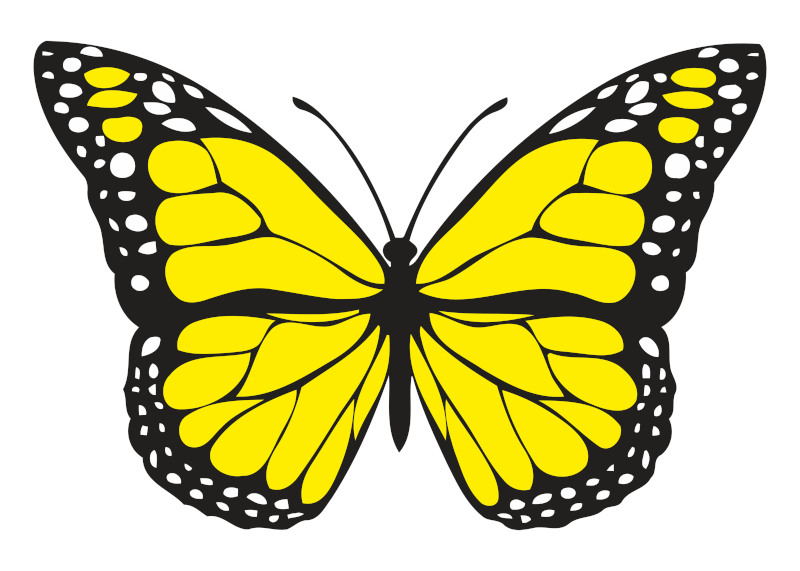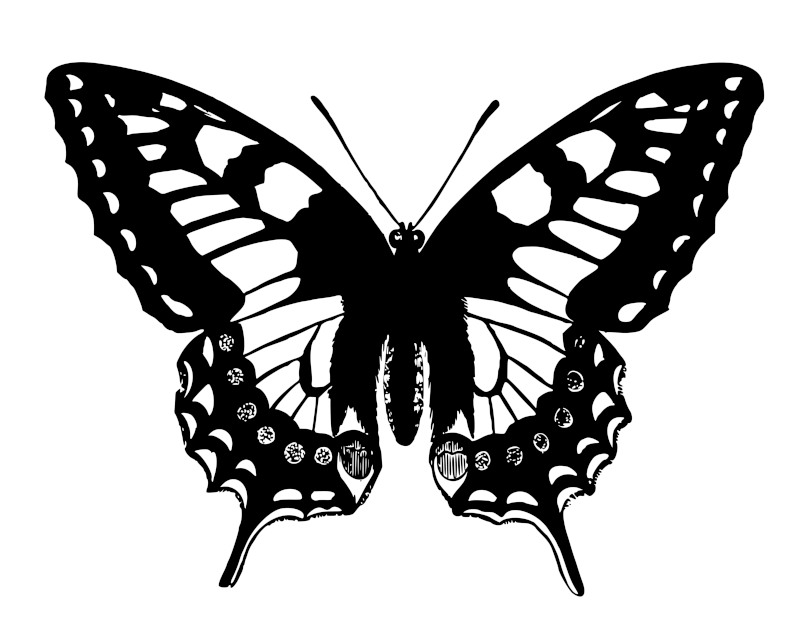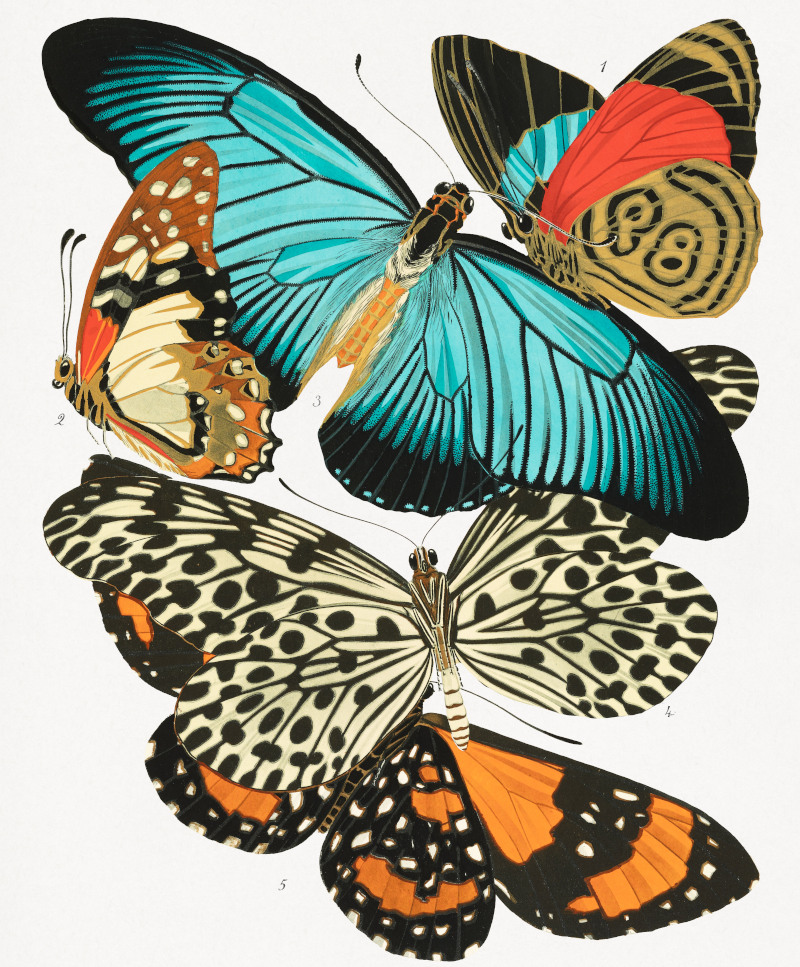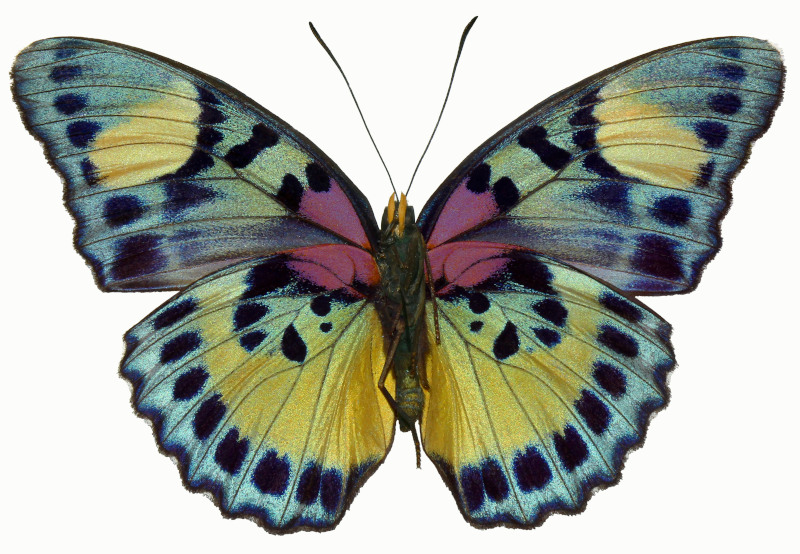Here we provide a list of easy butterfly drawing ideas, as well as some more complex, famous drawings from art history. There is also discussion about the role of butterflies within art more generally.
Introduction to Butterfly Drawings
Butterflies have been used within art for centuries, and have offered something unique to artists. The many species of butterflies have enabled a mixture of colors to be brought into each work, and they can also be used as the main focal point, or supporting elements within a composition. Some artists have gone to extraordinary lengths to better understand the inner workings of these stunning creatures, whilst others have merely enjoyed their aesthetic value.
Over the years, and across many different cultures, butterflies have appeared in a wide range of mediums, including watercolors, pencil and chalk drawings and also more complex oil paintings. Their natural beauty has translated into a wide range of artistic styles too, ranging from Impressionist art, all the way up to more contemporary genres.
List of Butterfly Drawings and Paintings
We have brought together a large selection of butterfly drawings and paintings from the realms of art history, and have aimed to deliver as wide and varied a display as possible, outlining the many different interpretations of butterflies that have been used by illustrators, painters and watercolor artists over the preceding centuries. Each image is listed alongside small details about the artist themselves.
In addition to the list of drawings below, there is also a wider discussion about the use of butterfly art across different continents and cultures, with Asian butterfly art being particularly famous and respected. This stunning creature has also been used to represent different things in different contexts, and also art has been used as a means to educating people about the different butterfly species currently in existence.
Butterfly Silhouette
This simple silhouette provides an image of a butterfly with most detail removed, and is an excellent choice for sketching purposes. Those re-producing this image digitally, will also be able to alter colors fairly easily. For others, you might observe the key sections of the insect, such as the patterns on the wings, as well as the main body of the butterfly.
Green birdwing (Ornithoptera priamus) by Charles Dessalines D' Orbigny
This delightful drawing was part of a wider series by Charles Dessalines D' Orbigny, a French illustrator who regularly produced accurate drawings of various animals and insects. In order to turn this drawing into a presentable artwork, he adds the name of the butterfly underneath and includes some quick sketches below the main artwork. Its colors are extraordinary, with this piece being one of the most popular of the series.
 by Charles Dessalines D' Orbigny.jpg) Green birdwing (Ornithoptera priamus) by Charles Dessalines D' Orbigny
Green birdwing (Ornithoptera priamus) by Charles Dessalines D' Orbigny
Insects, Butterflies, and a Dragonfly by Jan van Kessel
Here, Jan van Kessel produced a stunning collection of insect drawings together in the same composition. His depictions were charming, and clearly he was interested in understanding different insects through his work. He applied a reflective light onto each, and was less about scientific illustration, more about art than some other artists from around this period.
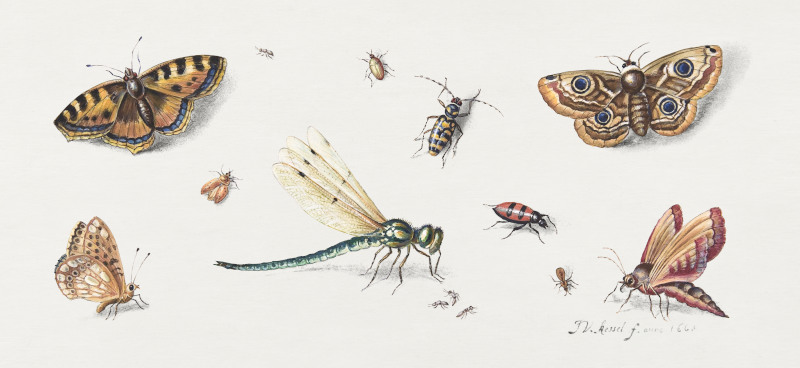 Insects, Butterflies, and a Dragonfly by Jan van Kessel
Insects, Butterflies, and a Dragonfly by Jan van Kessel
Butterflies Illustration (1910) by Morimoto Toko
Morimoto Toko was a respected Japanese artist from the 19th and 20th century who regularly used butterflies in his work, sometimes incorporating them in a natural habitat. He worked using a light touch which entirely suited this theme. He also mastered butterflies by capturing many times across his career.
 by Morimoto Toko.jpg) Butterflies Illustration (1910) by Morimoto Toko
Butterflies Illustration (1910) by Morimoto Toko
Different Types of Butterfly Illustrated by Charles Dessalines D' Orbigny
Charles Dessalines D' Orbigny was a true master of butterfly drawing and in this example he delivers four different species at two stages of their life. The formly formed butterflies are colored delightfully and details across their wings are completed to a high level of detail. Additional single elements are sketched alongside to provide educational art.
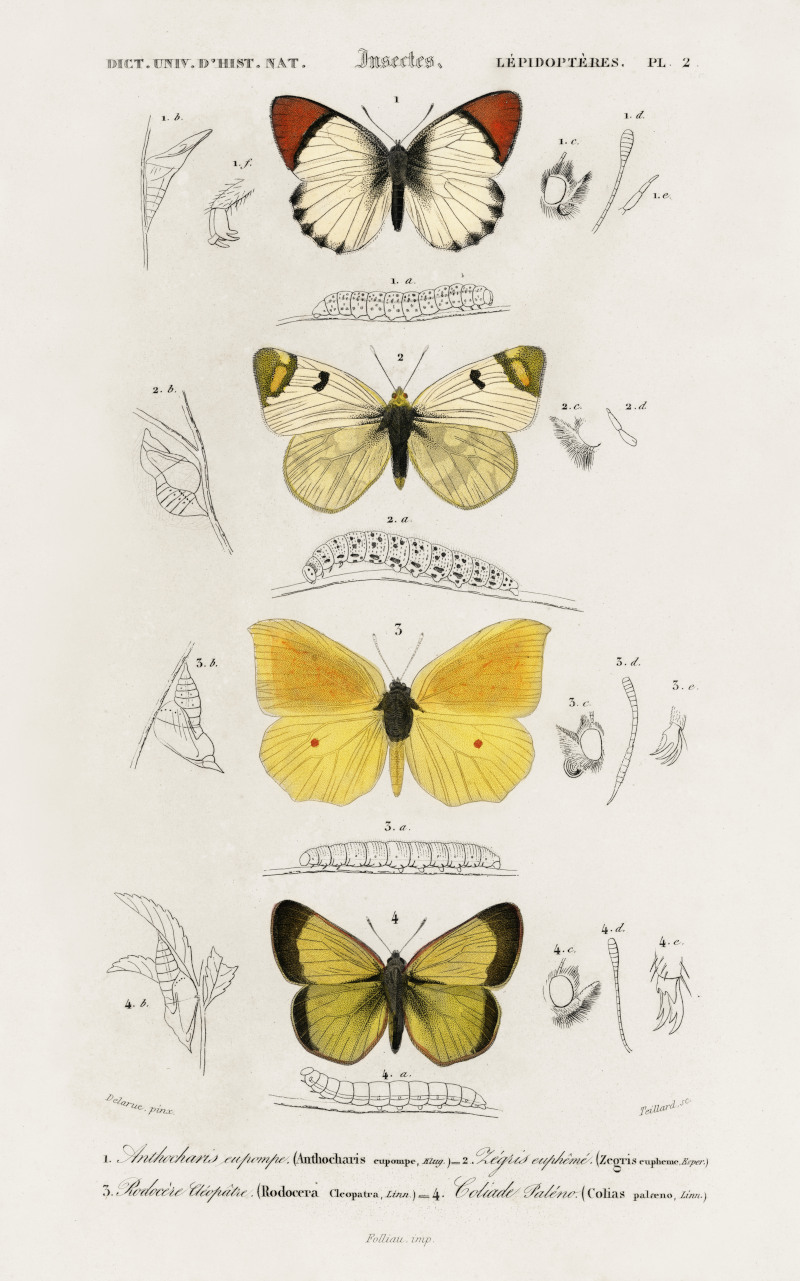 Different Types of Butterfly Illustrated by Charles Dessalines D' Orbigny
Different Types of Butterfly Illustrated by Charles Dessalines D' Orbigny
Japanese Butterflies by Kamisaka Sekka
Kamisaka Sekka's approach to painting and sketching butterflies underlines his connection to Japanese art, with a unique artistic style found within this nation. Japanese artists were devoted to nature in large numbers, and butterflies seemed to perfectly match their gentle, feminine approach which helped to make their work so popular, on a global basis. Trade with other nations helped to draw attention to their work, particularly in the 19th and early 20th century.
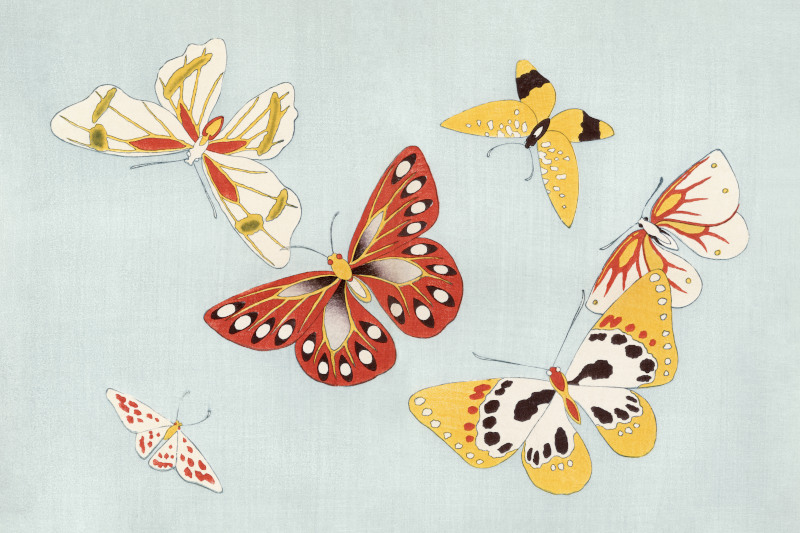 Japanese Butterflies by Kamisaka Sekka
Japanese Butterflies by Kamisaka Sekka
One Thousand Butterflies by Kamisaka Sekka
Kamisaka Sekka returns again here in another example from his series known as One Thousand Butterflies. He tended to place around five or six different species into each design, giving more of a natural style to his work than the Europeans who focused on accuracy in a slightly scientific manner. He would contrast colors across the complementing choices in order to deliver a charming artwork.
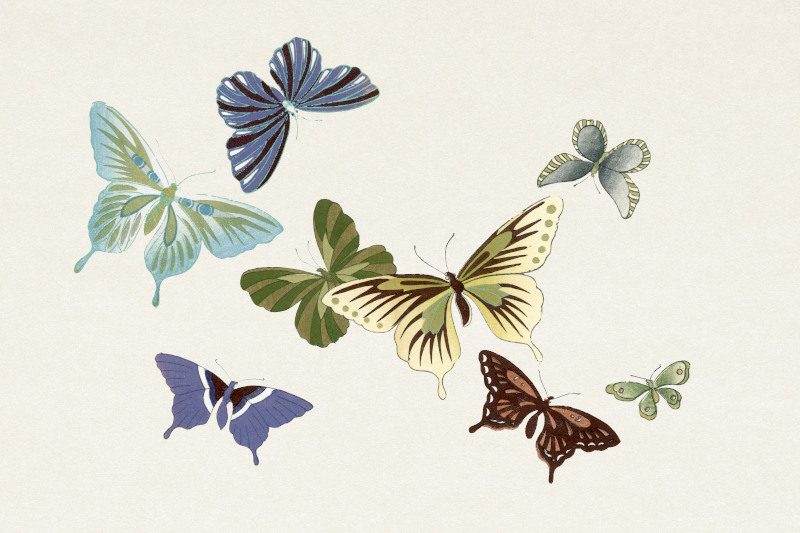 One Thousand Butterflies by Kamisaka Sekka
One Thousand Butterflies by Kamisaka Sekka
Different Types of Butterfly Illustrated by Charles Dessalines D'Orbigny
Charles Dessalines D'Orbigny was one of the most skilled butterfly draughtsmen, and the level of accuracy and detail found in his artworks was truly extraordinary. Indeed, he is featured several times in our list in this article, and he spent years researching these stunning creatures and could have been considered an expert in them by the end of his career, such was his knowledge of this subject.
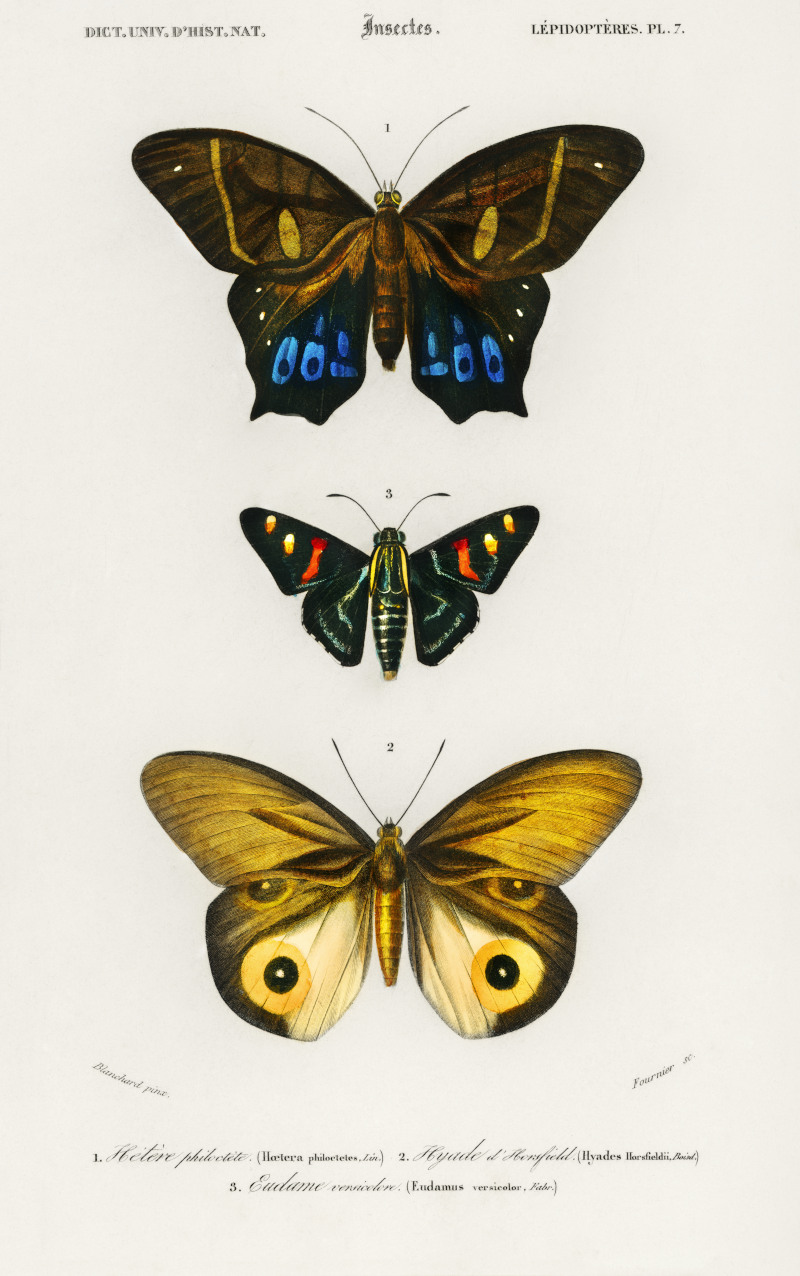 Different Types of Butterfly Illustrated by Charles Dessalines D'Orbigny
Different Types of Butterfly Illustrated by Charles Dessalines D'Orbigny
Butterflies and Moths in Le Jardin Des Plantes by Paul Gervais
This series by Paul Gervais combines a complex arrangement of flowers and butterflies together, reaching a charming balance between scientific observation and art. The level of detail here is amongst the best we could find, and this approach still works today just as well as it would have done when first publishing. The title is added simply to the bottom of the work, and a variety of colors helps to enchant the viewer.
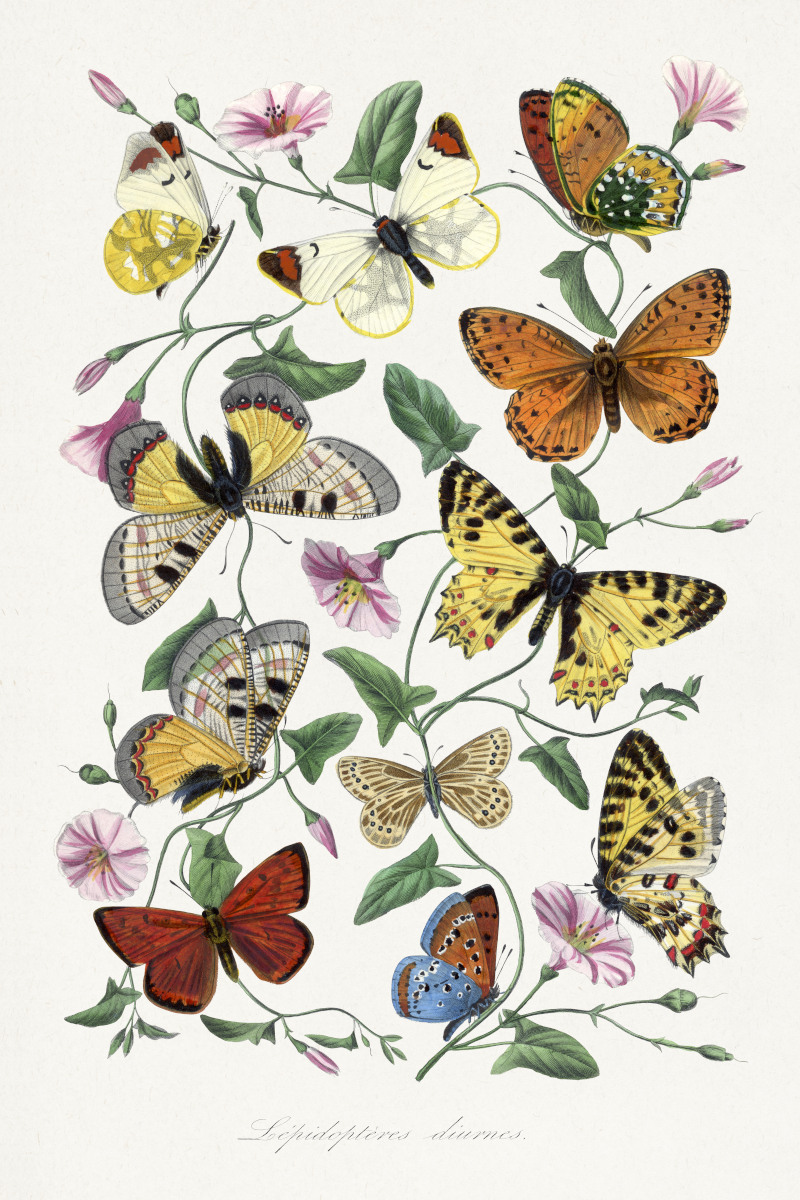 Butterflies and Moths in Le Jardin Des Plantes by Paul Gervais
Butterflies and Moths in Le Jardin Des Plantes by Paul Gervais
Beautiful Butterfly (Close-Up)
This large close-up is perfect for tracing the outlines. The colors are bold and detail is limited, enabling anyone to be able to sketch the details without any prior practice. Once this type of image has been mastered, then perhaps consider moving onto something more challenging, and also other butterfly species.
.jpg) Beautiful Butterfly (Close-Up)
Beautiful Butterfly (Close-Up)
EA Seguy Vintage Butterflies
EA Seguy overlapped bright and bold butterfly illustrations to create a unique style which proved popular and helped to raise the profile of his entire career. One can easily use these in a contemporary home, because of the impactful palettes that he used and the modern manner in which he laid out his designs.
Monarch Butterfly (Danais Archippus) by Sherman F Denton
 by Sherman F Denton.jpg) Monarch Butterfly (Danais Archippus) by Sherman F Denton
Monarch Butterfly (Danais Archippus) by Sherman F Denton
Blue Butterfly (Close-Up Detail)
.jpg) Blue Butterfly (Close-Up Detail)
Blue Butterfly (Close-Up Detail)
Large Multi-Colored Butterfly
Yellow Simple Line Illustration of Butterfly
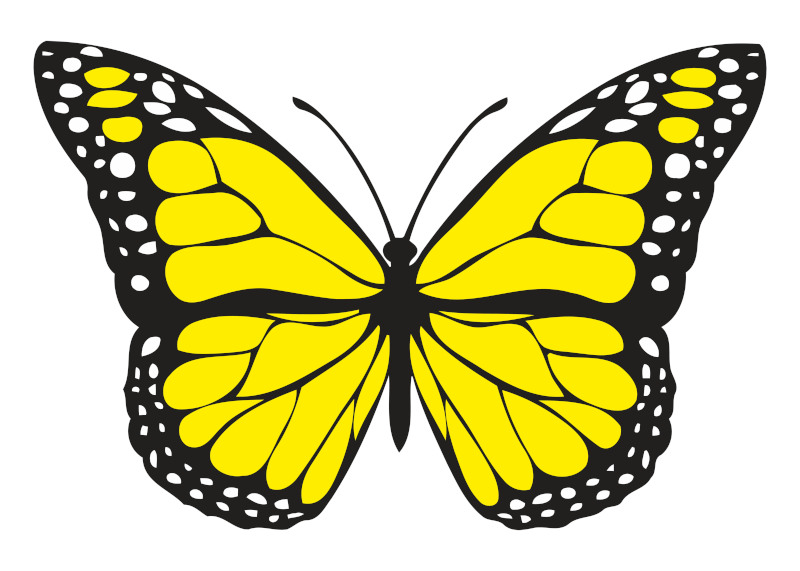 Yellow Simple Line Illustration of Butterfly
Yellow Simple Line Illustration of Butterfly
Butterfly Drawing of Laertes by by George Shaw
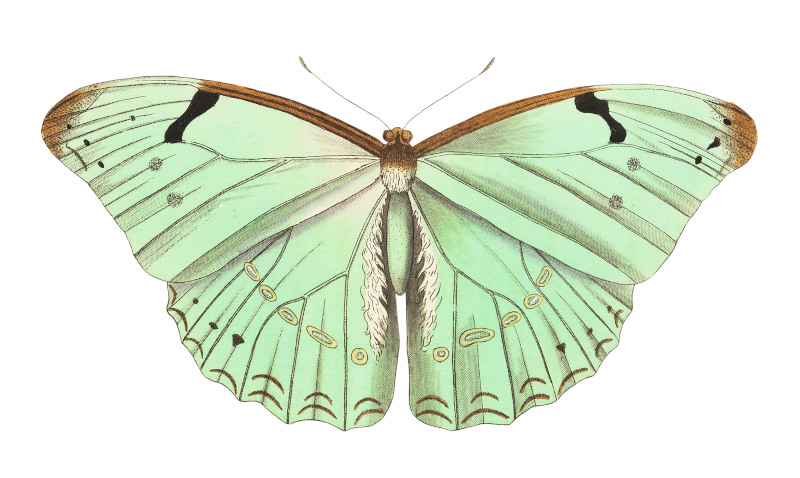 Butterfly Drawing of Laertes by by George Shaw
Butterfly Drawing of Laertes by by George Shaw
Butterfly Drawing in Ancient Civilizations: A Glimpse into Early Artistic Representations
In Mesoamerican times, pottery would be produced with butterfly motifs, representing fertility and also an abundance and strong health regarding agricultural output. There were also sculptures made of various insects, as well as more standard paintings. The goddess Psyche appeared within Greek and Roman society, representing the soul through her butterfly wings, touching on some of the earliest use of butterfly symbolism.
The ways in which butterflies have been used within art has also given us a guide to the progression of different cultures, as their knowledge and understanding of these creatures has advanced over time. The victorians, for example, would produce incredibly accurate drawings, serving as educational guides to some of the more common species, and also helping to track foreign travel by collectors as they started to encounter species from other regions.
The Artistic Evolution of Butterfly Drawings: From Ancient to Contemporary
The use of butterflies within art can be traced back as far as the ancient eras of Egypt, Greece, Rome, and Mesoamerica, where the symbolic values of these creatures could be used within early forms of art. Many were also aware of the cycle of life with butterflies, and would use them to represent this within their work. In more recent times, the aesthetic value of butterflies had been more relied upon, with many 20th century artists desiring work that immediately captured one's excitement, without any symbolic value being needed.
Across the 19th century we would see a fashion for collecting insects, often displaying them in cabinet cases. This led to artists drawing insects in a similar fashion, listing a number together and allowing us to visually compare their differences. Butterflies would become the most popular choice for this because of the beauty of their wings, and the appropriate sizes that most had. Other artists have incorporated them within scenes of summer, as a means to set the mood within their work, including a number of painters connected to the Impressionist era.
Fluttering Colors: Unraveling the Palette of Butterfly Drawings
We are now aware of the full gamit of butterflies, and this enables artists to find one suitable to their work. Every possible combination of color and hue is represented somewhere, with most based on tones typical within the rest of the natural world. Some of the most popular choices range from red, orange, and yellow to the alternatives of blues, greens, and purples, with countless combinations of them also available.
Those familiar with digital art will also recognise the further opportunities available for those wishing to tweak these combinations using software, thus bringing about an even greater number of possibilities. Butterflies also hold different patterns upon their wings, and these can also be harnessed by artists, as well as the other structural elements of each species.
Exploring the Art of Butterfly Drawings: From Pencil to Pixel
Pencil sketches of butterflies are particularly common, and often great ways for artists to evolve their technique. Children will often sketch butterflies, using simple, easy pictures from which to copy initially. Later on, they might then challenge themselves with more complex works, such as those listed in this article. Pencils are also ideal for these early works, as children will likely already be familiar with these tools.
Alternatively, artists may paint in watercolors, and the light, softness of this medium seems to fit the mood of a butterfly. The translucent nature works well with a butterfly's wings, whilst perhaps a more blunt tool can be used for the slim elements of the creature. More abstract versions can be delivered with oils and acrylics, and much will depend on the tools available to the artist at the time, as well as their experience in using each option. Finally, an alternative to standard pencils could be pastels, which bring in greater color options, and are also easy to carry around and work, unlike painted alternatives.
From Renaissance to Rococo: The Evolution of Butterfly Drawings in European Art
One of the key elements of the Renaissance era was in the improved accuracy found within its art. This included the structure of the body in portraits, but also in some depictions of animals and insects. Few Renaissance artists painted butterflies, but there are some examples of where artists studied creatures by sketching their parts, often repeating the process as a means to developing their techniques.
The Baroque era started to use butterflies as supporting elements within their paintings, but also for the purposes of symbolism. In a similar manner to ancient civilizations, butterflies would still be used to represent the cycle of life, which could be used in art in many different ways. Landscape painting was rare at this point, though, which did limit the use of butterflies up to this point. One may remember the likes of Durer, who were highly skilled in depicting plants, insects and animals as drawings or watercolor paintings, and he was joined by a number of others within the northern Renaissance.
The extravagance of the Rococo brought the butterfly motif into the mainstream, and would be spread across furniture design, jewelry, porcelain and patterned clothing as art started to spread into other fields. The next phases would be impacted by the fashion for collecting, and this encouraged artists to become more precise with their reproductions of the various species.
Exploring Eastern Aesthetics: Butterfly Drawings in Asian Art History
Asia has provided us with perhaps the finest butterfly artworks over the centuries, with this creature holding a particuarly strong role within art across a number of different Asian cultures. Chinese, Japanese, and Korean have often embraced nature, and also made use of light, sensitive imagery which are entirely suited to the butterfly form. Some have argued that they help embody the spirit of Daoist and Confucian philosophies, with Chinese culture impacting other nations in the region.
Japanese Ukiyo-e woodblock prints have regularly used butterflies as tools of creative expression. Some have focused entirely in butterflies, whilst in other examples they may appear as patterns on clothing or simply support a complex landscape scene. Their symbolism can represent marital bliss, or general happiness, making their inclusion suitable for an artistic gift.
Butterflies have also been used in Indian miniature paintings, as well as manuscripts and can help to set the scene of a healthy garden, for example. Many of the characteristics associated with butterflies will be repeated across most cultures.
Scientific Illustrations: The Role of Butterfly Drawings in Early Natural History Studies
Butterfly drawings were highly valuable prior to the development of photography as a means to scientific study and education. The most talented draughtsmen were able ot accurately collate the individual components of the butterfly, representing a complex creature which varies from one species to the next. These accurate drawings helped to organise species into regions, helping them to be named and also keep an eye on numbers in the future for protection purposes.
This accuracy would eventually spread to cover other animals and insects too, whilst many were initially attracted to butterflies because of the natural beauty of the creature. Publications from the 19th century can still be used today, such was the quality of them, and the lengths to which the researchers went in replicating the features of each species.
The Victorian Fascination: Butterfly Drawings in the Age of Collecting
The Victorians were highly curious about the natural world, in part because of the amount of travel and exploration that some were now able to accomplish. Trade also allowed all sorts of knowledge to spread more widely, and eventually a number of victorians would start to express this interest within their own lives. Collecting was a part of that, with Entomology gaining substantial interest during this period.
The purposes of collecting was to better understand the various species, as well as to celebrate their beauty by arranging cabinets that protected subjects for the future. Many visitors would enjoy seeing new butterflies within these displays, and eventually artists would start to use them for their own work. Publications would collect some of the best collections together, and enable others to learn, and as the printing techniques improved, so did the accuracy of these reproductions.
Art Nouveau's Wings: Butterfly Drawings and the Nouveau Movement
The curvilinear lines of the butterfly, particularly in regards to its wings, were perfectly suited to the style used by Art Nouveau artists. The feminine nature of their work, with soft touches of detail, often surrounding female portraits, also matched the very nature of butterflies themselves. As such, they would be used regularly within this art form which was popular in 20th century Europe.
There was also the influence of Japanese art, and, as mentioned elsewhere, this would have brought Art Nouveau designers and illustrators into direct contact with butterflies within Japanese woodblock printing. In terms of symbolism, butterflies would also be used within the theme of the femme fatale, giving another use for the creature here. Besides standard visual art, butterflies also appeared within stained glass window designs as well as motifs across features of architectural design and interior design.
Modern Art and Butterflies: The Influence of Nature on 20th-Century Artists
The popularity of butterflies within art continued into the 20th century, with examples being used by Surrealists due to their connection to themes of birth and re-birth. Modern artists have even incorporated butterflies growing within art, and then flying off to represent life itself, which really has challenged and evolved the meaning of art. This has even given an organic life to artworks, though only a few specially designed locations would be able to handle works such as this.
Within the world of abstraction, butterfly wing patterns have been incorporated into art, allowing us to immediately recognise certain species, even without the rest of the insect present. Additionally, others have replicated butterflies within drawings with just a few lines of pencil or pen, playing on our existing knowledge of these creatures to be able to fill in the blanks in our own minds.
Virtual Butterflies: Digital Art and the Future of Butterfly Drawings
Digital art brings many new opportunities to butterfly enthusiasts and artists alike. Animations can be constructed to bring designs to life, as well as providing educational support on these creatures. Additionally, highly complex drawings can be slowly constructed over time, using digital software and tools, without having to work whilst oils or watercolors are drying, or having to manually erase mistakes. Hand crafted designs on tablets can also be easily adjusted in terms of the color palette in a matter of seconds, bringing unlimited options to the artist.
Additionally, augmented reality brings new opportunities in terms of interation, whilst the online world enables artists to share their designs between each other, regardless of where they live. Butterfly artists can also gain global interest in their work too.



